Ballydougan to Newry Strategic Trunk Mains Ph2b (2016)
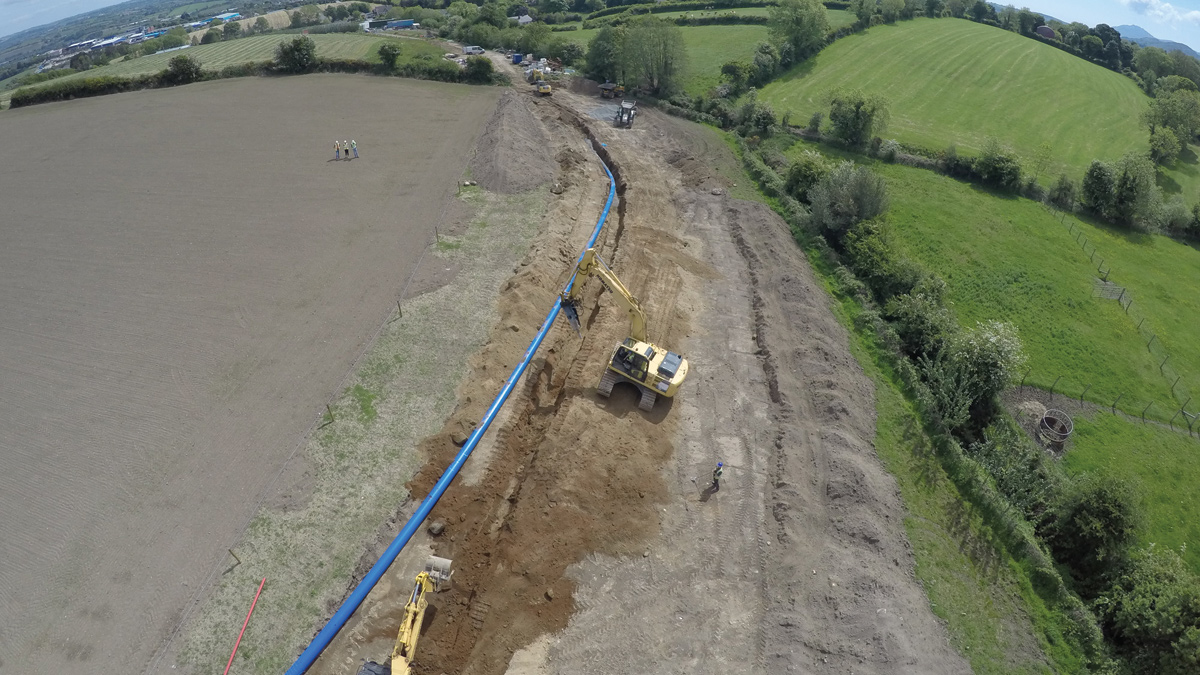
Laying 450mm HPPE pipework across feilds - Courtesy of NI Water
The Ballydougan to Newry Strategic Trunk Mains Project is the culmination of 10 years work and a £20m investment by NI Water to provide a strategic water main between Ballydougan Command Reservoir, supplied from Castor Bay WTW, and the Newry area. NI Water’s Water Resource Strategy identified the need for a number of strategic links to improve interconnectivity between water resource zones. The construction of this strategic link between Castor Bay WTW and the Newry and Lough Ross Resource Zones provides this link, addresses infrastructure deficiencies, and ensures security of supply and the delivery of high quality drinking water.
Introduction
NI Water is fully committed to improving the water supply infrastructure across Northern Ireland. To fulfil this objective and their regulatory obligations, the Ballydougan to Newry Strategic Trunk Mains Project was divided into three phases:
- Phase 1: An initial investment of £8m and completed by May 2011, witnessed the installation of a new 10km 600mm diameter trunk main from Ballydougan Command Reservoir to Scarva Water Pumping Station (WPS). This phase of the works also included the construction of a new pumping station at Belleeks and a new 4.5Ml service reservoir at Tullyhappy.
- Phase 2a: The second phase was £6m in value and involved a 20km extension of the 600mm diameter trunk main from Scarva WPS to Jerretspass WPS, where the main reduced to 500mm and continued onto Carnbane WPS. This phase of the scheme, which included major trenchless crossings of the Belfast-Dublin railway and Newry Canal, was completed in November 2013.
- Phase 2b: The third and final phase of the Ballydougan to Newry Strategic Trunk Mains Project, which commenced in October 2014, saw an investment of £6m to enhance the water supply to Newry and the surrounding areas. It is this phase of the project which is explored in greater detail throughout this paper.
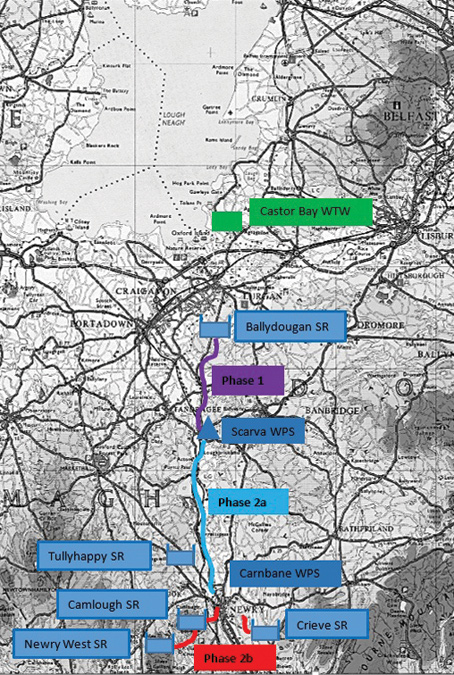
Ballydougan to Newry location and phase overview map – Courtesy of NI Water
Project aims and drivers
The Newry area continues to be supplied water from Fofanny WTW, an upland water source. However, as the population in the Newry area has increased, it has become clear that Fofanny WTW was going to be unable to sustain demand. A lack of distribution storage to the area east of Newry was also causing concern.
In 2010 the Newry and Lough Ross Resource Zone was put under severe strain as an unusually cold winter led to a sustained freeze/thaw which left a number of service reservoirs in the Newry area at critically low water levels for several days.
The primary aim of the Ballydougan to Newry Strategic Trunk Mains Project was to provide treated water to the Newry and the South Armagh area from Castor Bay WTW, which treats raw water from Lough Neagh. This ensured NI Water met the aims of its Water Resource Strategy as the new trunk main provides for greater interconnectivity between resource zones, provides security of supply to a population of around 50,000 and ensures future demand conditions can be met.
The final phase of the project addresses the remaining deficiencies in the Newry and Lough Ross Resource Zone highlighted in the Water Resource Strategy by augmenting supply from Fofanny WTW with the water from Castor Bay WTW and enhancing the water pumping station at Carnbane and increased storage provision at Crieve to ensure security of supply.
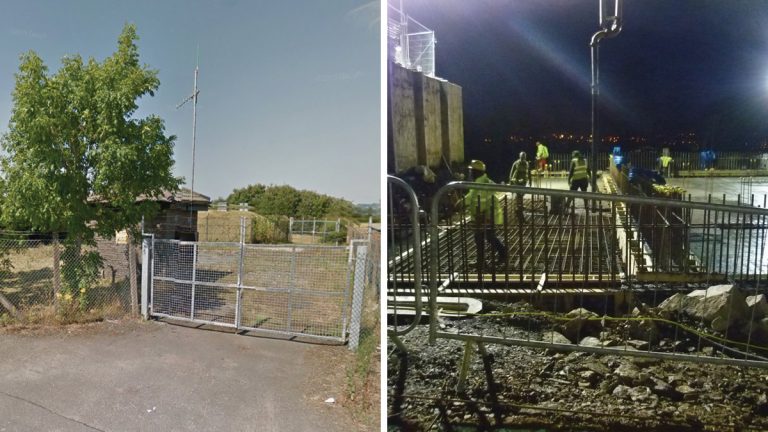
(left) Old Crieve SR and (right) Crieve cell 1 base pour with existing reservoir in service shown to the left – Courtesy of NI Water
What the project entailed
The project was split into several parts:
- Carnbane WPS: The project required the refurbishment and extension of Carnbane WPS increasing its capacity to 28.4Ml/d which enables flows to be delivered to Camlough SR and Newry West Service Reservoirs (SR) via 3 (No.) pumps sets (duty/assist/standby). A further 2 (No.) pump sets (duty/standby) ensures pumped flows to Crieve SR.
- Carnbane WPS to Camlough SR and Newry West SR Trunk Main: From Carnbane WPS a new 3.5km trunk main was installed in both roads and fields to Camlough SR and then onto Newry West SR. The trunk main consisted of a 2km 500mm diameter ductile iron section which provided the new inlet into Camlough SR. From Camlough SR a 1.5km 450mm HDPE pipe was installed to provide flow into Newry West SR. New flowmeters and inlet control valves were installed at both service reservoir sites. Chlorine dosing and sampling systems were installed within a newly constructed building at Camlough SR. Existing chlorine dosing and sampling equipment at Newry West SR was upgraded.
- Carnbane WPS to Crieve SR Trunk Main: From Carnbane an existing section of ductile iron trunk main was to be recommissioned to provide flows to Crieve SR. A new 3km section of 400mm diameter ductile iron pipe was tied into the existing main and installed in roads to complete the trunk main and provide the new inlet into to Crieve SR.
- Crieve SR: An existing 0.4Ml, single tank service reservoir at Crieve was demolished and replaced by a 4.2Ml, three-cell tank. Additionally a new control building was constructed and new flowmeters and inlet control valves were also installed.
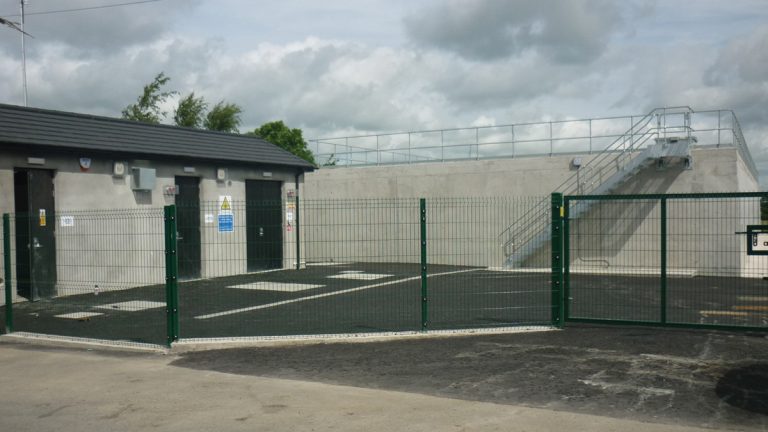
New 4.2ML Crieve Service Reservoir with chlorine dosing facility – Courtesy of NI Water
Design and operation
The design philosophy for the project is for the pumps at Carnbane WPS to maintain a pressure in each of the trunk mains. Flow into each of the reservoirs is then controlled by an inlet control valve (ICV), which reduces the need to rely on susceptible inter-site communications and ensures a more reliable network. The level in the reservoir controls the ICV to open or close between set level bands.
To maintain a more steady flow and fine tune the ICV opening, the average inlet flow over the past 7 days is calculated and the ICV adjusts to suit. This reduces wear and tear on the pumps from ramping up and down frequently to keep the reservoir ‘topped up’ and maintains a steadier draw of power from the electricity grid.
Carnbane WPS was designed to have three modes of operation as detailed below:
- Mode 1: This mode is for normal operation and using the Camlough/Newry wet pump sets provides flows of 7.2Ml/d to Camlough SR and Newry West SR, whilst the Crieve pump sets provides flows of 5.2Ml/d to Crieve SR.
- Mode 2: This mode is an emergency mode which enables reservoir levels to be recovered quickly following a period of down time. This mode inhibits the pumps to Crieve SR and can supply up to 22Ml/d to Camlough SR and Newry West SR.
- Mode 3: This mode allows for gravity flows from Fofanny WTW in cases where the pumping station is unavailable. Water from Fofanny WTW is fed under gravity SR through the new Crieve trunk main, through a cross connection at Carnbane WPS and allows supply to Camlough SR and Newry West SR via the new trunk main.
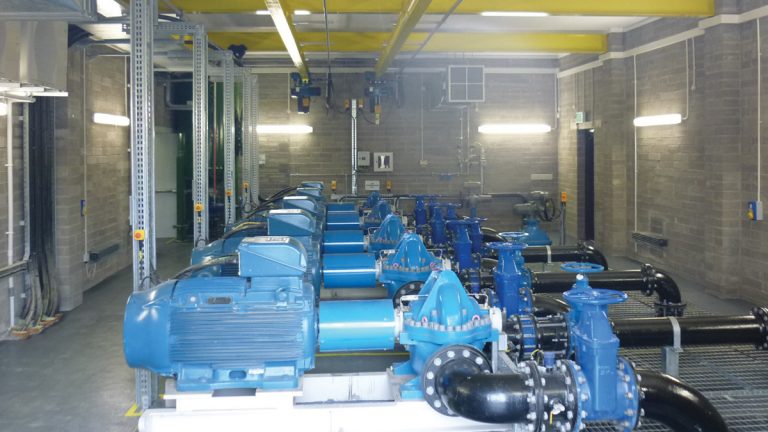
Refurbished Carnbane WPS – Courtesy of NI Water
Construction challenges
A design stipulation in the works information was for the existing system to continue to operate and suffer no unplanned interruptions or deterioration in the existing standard of service as a result of the construction works. This led to two significant design and construction challenges at the Crieve and Carnbane sites.
The first challenge was to construct one of the three new reservoir cells at Crieve SR adjacent to the existing tank which was to remain operational. A 12 hour night time shutdown was undertaken to change the existing water distribution main from the old tank to the new cell. All customers in this distribution area were informed in advance of the interruption and supply was reinstated 5 hours before the deadline. As the new tank was commissioned and operational the existing tank could then be demolished to make way for the construction of the remaining two cells of the new reservoir.
The second challenge was to extend and refurbish Carnbane WPS whilst keeping the existing pumps running. The existing inlet feed to the pumps was diverted using a temporary inlet pipe. This allowed for the new inlet mains, with associated flowmeter and strainer, to be installed. An existing surge vessel within the building was also repositioned to give sufficient space for 2 (No.) new pumps to be installed. The building structure was also extended in width by 4.5m to accommodate a new motor control centre (MCC).
With the building extended, new control panel and 2 (No.) pumps installed, the new inlet pipework was connected up. The newly laid trunk main to Camlough and Newry West was then commissioned and made operational allowing the decommissioning and removal of the existing pumps and control panel in Carnbane WPS.
Programming
The main aspect of the programme was to have beneficial use of the first cell of the new reservoir at Crieve by the end of March 2015. The site was accessed in mid-November and, following site clearance and rock breaking, the concrete base to the reservoir cell was poured in early January 2015 with the walls and roof following soon after.
Through collaborative organisation and communication between the client, project manager and site team the reservoir cell was completed and commissioned to deliver potable water to consumers in time to meet this key date.
Pipelines were planned for the summer months to make use of the school holidays which greatly reduced the impact on road users. The sections of trunk main across agricultural land were also laid in the summer months to benefit from drier ground to increase efficiency of pipe laying and reduce damage to the land by heavy machinery.
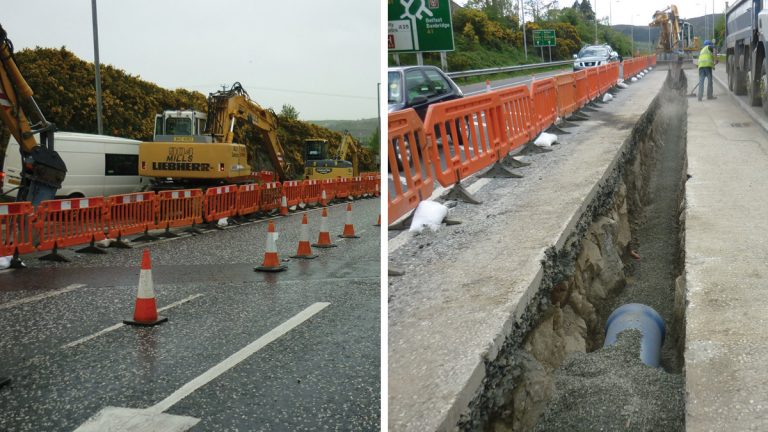
(left) Traffic management in place along Craigmore Way, Newry and (right) 500mm Ductile Iron Pipe being laid along Craigmore Way, Newry – Courtesy of NI Water
Procurement route
The project was advertised in the Official Journal of the European Union (OJEU) and invited expressions of interest to tender for the scheme. In total 6 applicants were successful in progressing from the pre-qualification questionnaire stage to tender stage. All successful applicants were construction companies based throughout the island of Ireland.
The project was tendered as a design and build project and used Option A, Priced Contract with Activity Schedule, of the NEC3 Engineering and Construction Contract. The project was awarded to the successful tenderer, BSG Civil Engineering Ltd, following assessment of tenders based on a price and quality ratio. The contract was awarded in October 2014.
Project team
The project team consisted of Capita Property & Infrastructure and BSG Civil Engineering Ltd as the principal contractor. The MEICA sub-contractor was Williams Industrial Services Ltd.
Capita Property & Infrastructure was appointed by NI Water as NEC Project & Cost Manager and was involved at an early stage in developing the scope, outline design, producing tender documentation, tender assessment and contract award. Capita was responsible for contract management, cost management and site supervision duties during the construction stages. Capita oversaw the testing and commissioning period through to a successful project handover to NI Water.
Public relations
To minimise the impact of the works on local residents and businesses during the construction phase a number of initiatives were implemented. These initiatives included: the use of VMS signage several weeks in advance of works to notify regular road users, night-time working at busy road junctions, traffic management to maintain traffic flow. Additionally, pipe-laying works were programmed for the summer months during school holidays to reduce traffic delays and work at reservoirs and pumping stations was confined to existing NI Water site boundaries.
The project engaged with the community via press releases, personal visits to home and business owners and a presentation and site visit for local councillors and political representatives. There was further liaison with the following groups: Newry & Mourne Council, Carnagat Residents’ Association and Transport NI. The scheme also provided a boost to the local economy through use of local labour, builders’ merchants, sign providers and office rental.
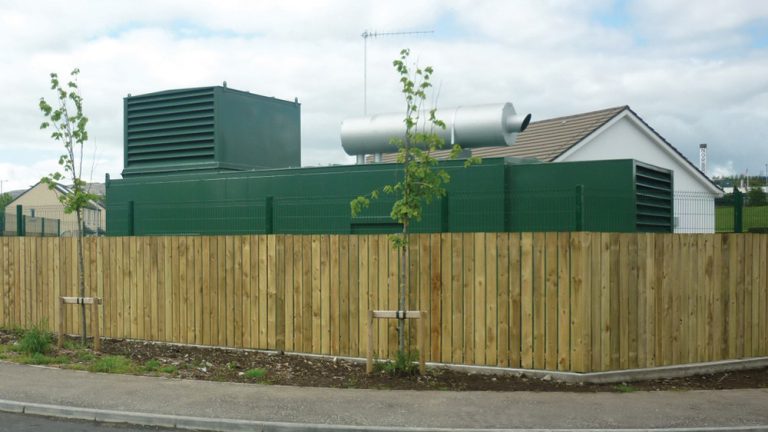
Fencing at Carnbane to reduce visual impact – Courtesy of NI Water
Commissioning and handover
The testing and commissioning stages of the project were undertaken between April and June 2016 which included the completion of the Operation and Maintenance Manuals, the Health and Safety File and site training for NI Water personnel.
This project has been delivered to a high standard of workmanship with an excellent safety achievement, recording no loss of man hours, as well as being on time and within budget. Final commissioning and handover to NI Water was in June 2016.



